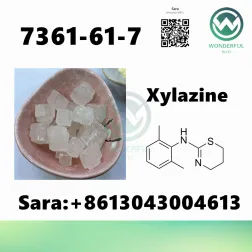Xylazine: Understanding its Uses, Effects, and Risks
Xylazine is a potent and versatile drug that has found its place in both veterinary medicine and, unfortunately, the world of illicit drug use. Its history, uses, effects, and associated risks make it a substance that warrants a closer look to understand its significance and potential dangers.
A Brief History of Xylazine
Xylazine, chemically known as 2,6-dimethyl-3,5-diphenyl-1,4-dihydropyridine-4-carboxylic acid 3,5-dimethyl-phenyl ester, was first synthesized in the 1960s. Initially developed as a veterinary sedative and analgesic, it quickly gained popularity due to its effectiveness in calming and immobilizing animals, particularly horses and cattle.
Veterinary Uses of Xylazine
In veterinary medicine, xylazine is primarily used as a sedative and muscle relaxant for large animals. Its ability to induce relaxation without complete loss of consciousness makes it a valuable tool for veterinary procedures such as surgery, diagnostic imaging, and hoof care. Xylazine can also be administered in combination with other drugs for more comprehensive anesthesia protocols.
Illicit Use and Risks
While xylazine has legitimate veterinary applications, its misuse has raised significant concerns. In recent years, reports have emerged of xylazine being used in combination with opioids, such as heroin or fentanyl, on the illicit drug market. This dangerous combination amplifies the risk of overdose and poses severe health threats to users.
Effects of Xylazine
When used as intended under veterinary supervision, xylazine produces a range of effects, including sedation, muscle relaxation, and analgesia (pain relief). These effects can be beneficial for animal care but become problematic when the drug is used recreationally or abused.
In the context of illicit drug use, xylazine can have a range of adverse effects on humans, including:
Respiratory Depression: Like opioids, xylazine can suppress respiratory function, leading to slow or shallow breathing. When combined with opioids, the risk of fatal respiratory depression increases significantly.
Hypertension and Bradycardia: Xylazine can cause high blood pressure and a slow heart rate. This combination can lead to cardiovascular problems and increase the risk of heart attacks.
Nausea and Vomiting: Xylazine can induce nausea and vomiting, which can contribute to further health complications when combined with other substances.
Muscle Weakness: In cases of overdose or misuse, xylazine can lead to extreme muscle weakness or paralysis.
Central Nervous System Effects: Xylazine can cause confusion, disorientation, and hallucinations when taken in high doses or mixed with other drugs.
Withdrawal Symptoms: Prolonged use of xylazine, especially when combined with opioids, can lead to severe withdrawal symptoms, making it challenging for users to quit.
Recognizing the Dangers
The emergence of xylazine in the illicit drug market has raised alarms among healthcare professionals, law enforcement agencies, and public health officials. Combining it with opioids increases the risk of overdose and death substantially. Therefore, it's crucial to recognize the dangers associated with this combination and raise awareness about its potential consequences.
Conclusion
Xylazine is a drug with legitimate veterinary uses that have been overshadowed by its misuse and abuse. While it remains a valuable tool in the hands of skilled veterinarians, its presence in the illicit drug market is a concerning trend. The combination of xylazine with opioids is a deadly cocktail that heightens the risk of overdose and poses significant health hazards to those who use these substances recreationally.
To address this issue, it is essential to continue monitoring and regulating the use of xylazine in veterinary medicine and raise awareness about the potential risks associated with its misuse. Education and outreach efforts can help individuals make informed decisions about the substances they use and promote safer practices that protect public health and safety.
691
0
0



Comments
All Comments (0)